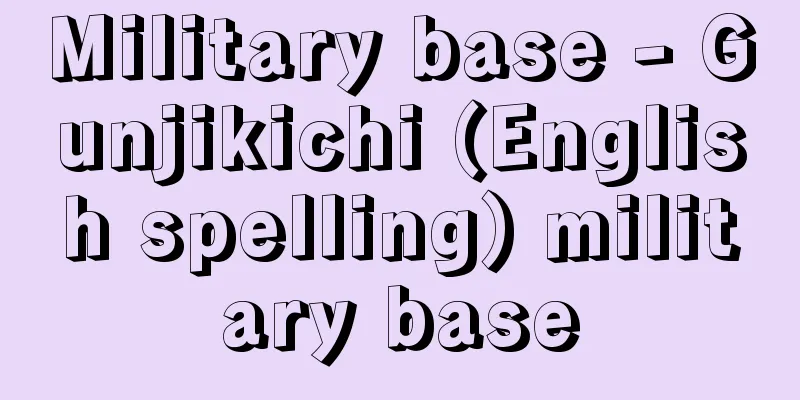Military base - Gunjikichi (English spelling) military base

|
A general term for the facilities and areas required by the military to conduct combat operations. [Takashi Matsuo] OverviewThe term military base generally refers to facilities and areas used by the military, but the concept is not always clearly defined and is used in a variety of ways. The broadest definition is when all facilities and areas used by the military are called military bases. The Ministry of Defense's definition, where the word "military" is taboo, is close to this. According to the Defense White Paper (1983 edition), all facilities and areas used by the Self-Defense Forces and the U.S. military are called "defense facilities," explaining that they are "the foundation for demonstrating defense power, and serve as bases for education and training and designated missions in peacetime, and as bases for defense activities in times of emergency." A narrower definition of a military base can be found in the Department of Defense Dictionary of Military and Associated Terms (1979) of the Joint Chiefs of Staff: "(1) A location from which operations are contemplated or supported. (2) An area or location containing facilities providing logistical or other support." In the narrow sense, military bases are defined as only facilities and areas directly used for military combat operations, and in this case bases are limited to "operation bases." However, due to the characteristics of modern warfare, namely, (1) it has become a total war of the nation, not just a war of military might, (2) the distinction between the front line and the rear has become relative due to the development of weapons such as missiles and aircraft, and (3) the military has become ready to respond to emergencies, with no clear distinction between peacetime and wartime, especially due to the electronicization of missiles and weapons, the concept of a military base has become broader. The actual form of a military base is diverse in response to the diversity of military activities, and consists of airfields (air bases), port facilities, ammunition depots, fuel depots, warehouses, communication facilities, radio interception facilities, training and exercise areas, barracks and housing facilities, offices, medical facilities, repair and maintenance facilities, etc. In addition, due to the characteristics of their functions, aircraft carriers are sometimes called "mobile air bases on the sea," and strategic nuclear missile-equipped nuclear submarines are sometimes called "submerged bases" or "underwater bases." Military bases can be categorized according to function or location as follows: forward bases for forward deployment of troops, operational bases that serve as direct bases for combat operations, supply and logistics bases to support operational activities, relay bases used on the way when deploying troops or supplies forward, and reserve bases that are not normally or in peacetime but are used when necessary or in times of emergency. They can also be categorized as forward-line bases or front-line bases that are directly involved in combat, and rear-area bases that are indirectly involved. The geographical location and manner in which military bases are located is determined based on a nation's military strategy and the troop deployment plans based on that strategy, but it is not determined solely by military rationale and is sometimes subject to economic and social constraints. [Takashi Matsuo] U.S. military bases in JapanA general term for the "facilities and areas" provided by the Japanese government to the U.S. military under the Japan-U.S. Security Treaty and the Japan-U.S. Status of Forces Agreement based on it (both of which came into effect in 1960). Article 6 of the Security Treaty states that the purpose of the bases is "to contribute to the security of Japan, and to international peace and security in the Far East." The extent of the "Far East" in this case has been one of the main points of contention in the Diet. The government initially stated that it meant "roughly the area north of the Philippines, as well as Japan and the surrounding areas (including Korea)," but in the 1980s it came to the view that "it does not indicate a specific geographical area." In any case, the government's view is that the area to which U.S. forces will be deployed for this purpose "will depend on the nature of the attack or threat, and will not necessarily be limited to the Far East." Historically, US military bases in Japan were first used as bases for attacks on the Japanese mainland (Okinawa) during the Pacific War, and then as garrisons for the Allied forces (mainly US forces) to carry out the occupation policy. During this period, the bases were established by order of GHQ (Supreme Commander for the Allied Powers). Later, as the Cold War between the US and the Soviet Union intensified, US military bases in Japan were positioned as part of a global network of bases to contain the Soviet Union based on a new US strategy. Based on this strategy, new bases were built and expanded, and the US military bases in Japan began to be reorganized as surveillance and attack bases for the Soviet Union and China. When the Korean War began in June 1950, U.S. military bases in Japan (including Okinawa) became the main bases for the U.S. military's operational activities in carrying out the war. Specifically, they fulfilled a variety of functions, including launching bases, logistics and supply bases, relay bases, and comfort and training bases. Furthermore, Japan's economic power and domestic transportation facilities were mobilized for war purposes, the entire country was turned into a "base," and any speech or actions against the war were forbidden and subject to punishment. In April 1952, the signing of the Peace Treaty with Japan made Japan an "independent nation," and in order to continue to secure its bases in Japan, the United States concluded the Japan-U.S. Security Treaty and the Administrative Agreement based on it with the Japanese government (both of which came into effect in April 1952). This agreement gave the United States the right to continue to use the bases it had secured during the occupation, and it also promoted the reorganization and strengthening of U.S. military bases in Japan as bases for the Soviet Union and China, based on the development of a new "strategy of massive retaliation." On the other hand, Okinawa was separated from mainland Japan by the peace treaty, and continued to be under the direct military administration of the U.S. military, and was to play the role of "the keystone of the Pacific Ocean." In June 1960, the Japan-US Security Treaty was revised and the Japan-US Administrative Agreement was replaced by the Japan-US Status of Forces Agreement, but the US military's various privileges were maintained. However, a new "Exchange of Notes on the Implementation of Article 6 of the Treaty" was exchanged for the use of US military bases, and the US side decided to make three items the "subject of prior consultation": (1) "significant changes in the disposition" of US military forces, (2) "significant changes in equipment," and (3) "combat operations" of US military forces conducted from the Japanese mainland. The specific provisions of these three items were decided in the "Fujiyama-MacArthur Verbal Understanding" (unpublished). Through questions and answers in the Diet, the Japanese government has narrowed the scope of "combat operations" in (3) extremely narrowly to "direct combat operations" (use as a launch base for sorties), and has indicated its position that the US military is free to use the base for other logistics and supply activities and "movement." (For (2) "nuclear introduction," see the "Three Non-Nuclear Principles" section.) From the late 1960s to the early 1970s, US military bases in Japan (including Okinawa) were used to the fullest extent possible for the Vietnam War as logistics and supply bases, relay bases, comfort and training bases, and bases for ploys. The importance of the US military bases in Japan was so great that one American general said, "There would be no Vietnam War without Japan." In May 1972, Okinawa was returned to Japan under the Japan-US Okinawa Agreement, and US military bases in Okinawa came to be subject to the Japan-US Security Treaty and the Status of Forces Agreement, which remain in place to this day. At present, there are 91 U.S. military bases in Japan exclusively for the U.S. military, covering an area of approximately 314 square kilometers, with approximately 75% of these concentrated in Okinawa Prefecture. Furthermore, since the 1980s, there has been a dramatic increase in the temporary use of Self-Defense Force bases by the U.S. military for "joint training," and the total area currently amounts to approximately 670 square kilometers (as of January 1997). In addition, water and airspace for training are provided to the U.S. military throughout Japan, and these have also been "turned into bases." [Takashi Matsuo] US-Soviet military basesDue to the Cold War and the development of nuclear weapons after World War II, the United States formed a global military alliance system (NATO, CENTO, SEATO, ANZUS, etc.) based on a military strategy of containment against the Soviet Union, surrounding the Soviet Union geographically, and at the same time built a network of bases against the Soviet Union. In the 1950s, bombers were the mainstay of strategic nuclear weapons, and the base network was constructed to have targets for attacking the Soviet Union within their combat radius. However, with the development of nuclear missiles, the US mainland came to be the frontline base from the 1960s. Also, from the mid-1960s, with the emergence of nuclear submarines equipped with strategic nuclear missiles (SLBMs), the oceans began to be "based". Furthermore, the United States has continued to maintain a global base network with conventional forces so that it can function as the "world's military police" not only in military confrontation with the Soviet Union, but also to protect its own interests. After the end of the Cold War, the United States adopted a new strategy in the 1993 Bottom-Up Review to win in two simultaneous regional conflicts on the scale of the Gulf War (in the Middle East and the Korean Peninsula), and deployed 100,000 troops overseas in Europe and 100,000 in Asia. The United States has deployed these troops at bases in Europe and Asia. On the other hand, until the mid-1960s, the Soviet Union had no overseas bases because it had been building up its military power against the United States through an internal line strategy using ICBM bases on the Soviet mainland and nuclear submarines equipped with strategic nuclear missiles. However, in Europe, it formed the Warsaw Pact to compete with NATO and built a network of military bases in Eastern European countries. In the 1970s, while the United States wasted its military strength in the Vietnam War, the Soviet Navy continued to strengthen its military power, and as a result, it came to possess an ocean-going fleet and began to secure "ports of call" all over the world. In December 1979, it invaded Afghanistan, and for the first time, it had overseas bases in countries other than the Warsaw Pact countries. Although the Soviet military had the ability to fight in multiple theaters simultaneously, the Soviet Union did not possess a global base network in the sense of the United States, due to geopolitical characteristics. The Soviet Union completed its withdrawal from Afghanistan in February 1989. On March 31, 1991, the Warsaw Pact was dissolved, ending the Cold War. As a result, the Soviet Union withdrew its troops from all of its overseas bases, and the newly formed Russia no longer has any overseas bases. [Takashi Matsuo] "US Department of Defense Report: Soviet Military Power 1985" (1985, Jiji Press)" ▽ "Soviet Ministry of Defense ed.: Threats to Peace - American Military Power 1985, 3rd Edition (1985, Nisso Tosho)" ▽ "Asakumo Shimbunsha ed.: Defense Handbook, 1997 Edition (1997, Asakumo Shimbunsha)" ▽ "Defense Agency ed.: Defense White Paper, various editions (Ministry of Finance Printing Bureau)" [Reference items] | | | | | Status of Forces Agreement |Source: Shogakukan Encyclopedia Nipponica About Encyclopedia Nipponica Information | Legend |
|
軍隊が戦闘作戦行動を展開するために、必要とする諸施設・区域の総称。 [松尾高志] 総説軍事基地ということばは軍隊が使用する施設・区域を一般的には示すが、その概念はかならずしも一義的に明確ではなく、さまざまな範囲に使用されている。 もっとも広い範囲での規定は、軍隊が使用するすべての施設・区域を軍事基地という場合である。「軍」という語が禁句である防衛省の規定はこれに近い。『防衛白書』(1983年版)によれば、自衛隊と米軍の使用するすべての施設・区域を「防衛施設」と呼称し、それは「防衛力発揮の基盤であり、平時においては教育訓練及び定められた任務を行う拠点となり、有事には防衛活動の拠点となるもの」と説明している。 より狭い範囲での軍事基地の規定としては、「(1)そこから作戦が企図され、あるいは作戦が支援される場所。(2)兵站(へいたん)あるいはその他の支援を提供する施設の存する区域あるいは場所」との、米統合参謀本部の『軍事用語辞典』Department of Defense Dictionary of Military and Associated Terms(1979)の「基地」baseの規定をあげることができる。 狭義の規定では、軍隊の戦闘行動に直接使用される施設・区域のみを軍事基地とするが、この場合の基地は「作戦基地」operation baseに限られる。 しかし、現代の戦争の様相――すなわち、〔1〕それが単に軍事力のみによらず国家総力戦となったこと、〔2〕ミサイル・航空機などの兵器の発達により、前線と後方の区別が相対的なものとなったこと、〔3〕とくにミサイルと兵器のエレクトロニクス化により、平時と戦時が明確に区別されることのない「有事即応」の態勢を軍隊が保持するようになったことなど――の特質から、軍事基地の概念はより広いものとなってきているといえよう。軍事基地の実体的な形態は軍事活動の多様性に対応して多様であり、飛行場(航空基地)、港湾施設、弾薬庫、燃料庫、倉庫、通信施設、無線傍受施設、演習・訓練場、兵舎・住宅施設、事務所、医療施設、修理・整備施設などからなる。なお、その機能の特性から、空母(航空母艦)を「海上機動航空基地」、戦略核ミサイル搭載原子力潜水艦を「潜る基地」あるいは「水中基地」と称することがある。 軍事基地は機能あるいは位置により、次のように区分することができる。兵力を前方展開しておくための前進基地、戦闘作戦行動の直接の拠点となる作戦基地、作戦行動を支援するための補給・兵站基地、兵力あるいは補給品を前方に展開する際に途中で使用する中継基地、通常あるいは平時には使用していないが必要が生じあるいは有事に使用するための予備基地などである。また、直接戦闘に関与する前線基地・第一線基地と、間接的に関与する後方基地とに区分する場合がある。 軍事基地を地理的にどこにどのように配置するかは、その国家の軍事戦略と、それに基づく兵力配置の構想に基づいて決定されるが、単に軍事的合理性のみによって設定されるわけではなく、経済的あるいは社会的制約を受けることがある。 [松尾高志] 在日米軍基地日米安全保障条約とそれに基づく日米地位協定(ともに1960年〈昭和35〉発効)によって、日本政府が米軍に提供している「施設及び区域」の総称。 基地の使用目的は、安保条約第6条によって「日本国の安全に寄与し、並びに極東における国際の平和及び安全に寄与するため」とされている。ここでの「極東」がどの範囲であるのかが、これまで国会での主要な争点の一つとなってきた。政府は当初、「大体においてフィリピン以北並びに日本及びその周辺の地域(韓国を含む)」としていたが、1980年代に入ると、「特定の地理的範囲を示すものではない」との見解をとるようになった。いずれにしても、この目的のために米軍が出動する範囲は「その攻撃または脅威の性質いかんにかかり、かならずしも極東に限られない」というのが政府見解である。 在日米軍基地は、歴史的には、まず太平洋戦争での対日本本土攻撃の拠点(沖縄)、そして占領政策の遂行のための連合国軍(米軍が主体であった)の駐屯地として使用を開始された。この時期は基地の設置はGHQ(連合軍最高司令部)の命令による接収により行われた。その後、米ソの冷戦の激化に伴い、在日米軍基地はアメリカの新戦略に基づく対ソ封じ込めの世界的な基地網の一環として位置づけられた。この戦略に基づき基地の新設・増強が行われ、在日米軍基地はソ連および中国に対する監視・攻撃拠点としての再編成が着手された。 1950年(昭和25)6月に朝鮮戦争が開始されると、在日米軍基地(沖縄を含む)は、この戦争遂行のための米軍の作戦行動の主要拠点となった。具体的には、出撃基地、兵站・補給基地、中継基地、慰安・訓練基地などあらゆる機能を果たすこととなった。また日本の経済力、国内輸送機関が戦争目的のために動員され、全土が「基地化」され、戦争に反対する言論・行動は禁じられ、処罰の対象とされた。 1952年4月、対日講和条約の調印により「独立国家」となった日本に、従来どおり基地を確保するため、アメリカは日本政府との間で日米安全保障条約とそれに基づく日米行政協定を締結した(ともに1952年4月発効)。この取決めによって、アメリカは占領下で確保した基地を引き続き使用する権利を獲得したほか、新たな「大量報復戦略」の展開に基づく対ソ・対中基地としての在日米軍基地の再編・強化を推し進めた。他方、沖縄は講和条約によって日本本土と切り離され、引き続き米軍の直接の軍政下に置かれ、「太平洋のキー・ストーン(要石(かなめいし))」としての役割を担うこととなった。 1960年6月には日米安全保障条約の改定、日米行政協定の日米地位協定への切り換えが行われたが、米軍の諸特権は維持された。ただ、米軍の基地使用にあたっては、新たに「条約第6条の実施に関する交換公文」が取り交わされ、(1)米軍の「配置における重要な変更」、(2)「装備における重要な変更」、(3)日本本土から行われる米軍の「戦闘作戦行動」の3項目についてはアメリカ側から「事前協議」の「主題」とすることになった。この3項目が具体的に何を規定しているのかは「藤山・マッカーサー口頭了解」(不公表)で取り決めている。(3)の「戦闘作戦行動」の範囲は国会での質疑を通じて、日本政府はその内容をきわめて狭く絞り込んで、「直接戦闘行動」(出撃発進基地としての使用)に限定し、それ以外の兵站・補給活動、「移動」は米軍に自由使用を認めるとの立場を示している。((2)の「核持ち込み」については「非核三原則」の項参照)。 1960年代後半から70年代初頭にかけては、在日米軍基地(沖縄を含む)は、ベトナム戦争のために、兵站・補給の拠点、中継基地、慰安・訓練基地、謀略拠点などとして、最大限に利用された。一アメリカ将軍をして「日本なくしてベトナム戦争なし」といわしむるほど、在日米軍基地の重要性は高いものであった。1972年5月には、日米沖縄協定により沖縄は日本に返還され、在沖縄米軍基地は日米安保条約と地位協定の適用を受けることとなり、現在に至っている。 現在、在日米軍基地は米軍専用のものが91件、面積にして約314平方キロメートルであり、その約75%が沖縄県に集中している。さらに、80年代以降は、「共同訓練」を名目とする米軍の自衛隊基地の一時使用が激増する傾向にあり、現在、その面積は約670平方キロメートルに及んでいる(1997年1月現在)。加えて、米軍には訓練水域および訓練空域が日本各地で提供されており、これらもまた「基地化」されている。 [松尾高志] 米ソの軍事基地第二次世界大戦後の冷戦と核兵器の発達により、アメリカは対ソ封じ込めの軍事戦略に基づき、ソ連を地理的に包囲する形で全世界的な軍事同盟体制(NATO(ナトー)、CENTO(セントー)、SEATO(シアトー)、ANZUS(アンザス)など)を構成すると同時に、対ソ基地網を建設した。1950年代には、戦略核兵器としての爆撃機が中心であったため、その戦闘行動半径内に対ソ攻撃目標をもつように基地網が構成されたが、核ミサイルの発達により、60年代からは、アメリカ本土を第一線基地とするに至った。また60年代なかばからは、戦略核ミサイル(SLBM)搭載原子力潜水艦の出現により、海洋をも「基地化」するようになった。さらに、アメリカはソ連との軍事対決のみならず、自国の権益擁護のため、「世界の憲兵」として機能しうるよう通常兵力によるグローバルな基地網を維持し続けてきた。 冷戦終結後、アメリカは1993年の「ボトムアップ・レビュー」で湾岸戦争規模の地域紛争2か所(中東、朝鮮半島を想定)の同時発生に勝利するとの新戦略を採用し、海外展開兵力をヨーロッパ10万人、アジア10万人体制とした。アメリカはこの兵力をヨーロッパ、アジアの基地に配備している。 他方、ソ連は1960年代なかばまで、ソ連本土のICBM基地と、戦略核ミサイル搭載原子力潜水艦による内線戦略による対米軍事力を構築していたために海外基地はもたなかった。ただ欧州正面ではNATOに対抗してワルシャワ条約機構を結成し、東欧諸国に軍事基地網を構成した。70年代に入ると、アメリカがベトナム戦争で兵力を消耗している間に、軍事力を増強し続けた結果、ソ連海軍は外洋艦隊を保有するに至り、世界各地に「寄港地」を確保し始めた。また79年12月にはアフガニスタンに侵攻し、初めてワルシャワ条約国以外の国に海外基地をもつこととなった。ソ連軍が複数の戦域で同時に戦闘する能力をもつに至ったとはいえ、アメリカのような意味でのグローバルな基地網は地政的特性からも、ソ連は保有していなかった。 1989年2月、ソ連軍はアフガニスタンからの撤兵を完了した。91年3月31日、ワルシャワ条約機構が解体して、いわゆる冷戦が終結した。これに伴いソ連軍はすべての外国基地から撤兵し、新生ロシアは海外基地をもっていない。 [松尾高志] 『アメリカ防総省報告書『ソ連の軍事力 1985』(1985・時事通信社)』▽『ソ連国防省編『平和を脅かすもの――アメリカの軍事力1985』第3版(1985・日ソ図書)』▽『朝雲新聞社編『防衛ハンドブック・平成9年度版』(1997・朝雲新聞社)』▽『防衛庁編『防衛白書』各年版(財務省印刷局)』 [参照項目] | | | | | |出典 小学館 日本大百科全書(ニッポニカ)日本大百科全書(ニッポニカ)について 情報 | 凡例 |
>>: Militarization - Gunjika (English spelling) militarization
Recommend
Toxoplasmosis
Definition: An infectious disease caused by Toxopl...
Shijo Miyashita - Shijo Miyashita
Dates of birth and death unknown. A female poet o...
Kim Chiha
A Korean poet. His real name is Kim Young-il. He ...
Industrial Safety and Health Act
Abbreviation for "Occupational Safety and Hea...
Isoindolinone pigment - Isoindolinone pigment
A type of high-grade pigment that is mainly yellow...
Principle of change of circumstances - clausula rebus sic stantibus (Latin)
It is an implicit contract that all contracts are...
Antoninianus Silver Coin - Antoninianus Silver Coin
…He aimed to become the second Alexander the Grea...
Koshiro Matsumoto
A Kabuki actor whose stage name has been Kouraiya...
Dumani
…Attempts were made from the southwest side in 19...
Yoshimi Usui
Born June 17, 1905 in Mita, Nagano [Died] July 12,...
Natural numbers
Natural numbers are numbers used to count things ...
Wooden sweets - Kigasi
〘Noun〙 Fruit. Originally, sweets referred to fruit...
Aotenma - Aotenma
...There are two pollinia. The green variety is c...
Existing conditions - Existing conditions
...Conditions relate to future facts. Past facts ...
Working People's Cultural Palace (English: Working People's Cultural Palace)
A center for cultural, artistic, and sports activi...







![Yomogita [village] - Yomogita](/upload/images/67cd1bbf32725.webp)

